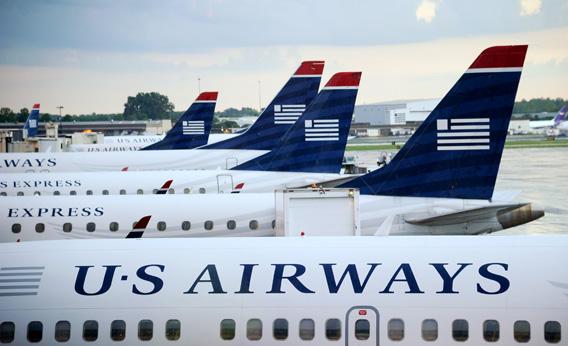 The merger between US Airways and American Airlines marks the end of the era of cheap domestic airfares
The merger between US Airways and American Airlines marks the end of the era of cheap domestic airfares Photo by Kevork Djansezian/Getty Images
Time to shed a tear into your tiny plastic cups of tomato juice, because the merger between US Airways and American Airlines announced last week marks the end of the era of cheap domestic airfares. Thanks to Northwest?s takeover by Delta, Continental?s takeover by United, and AirTran?s takeover by Southwest, and now this, four giant airlines will soon control about 70 percent of the American market.* That?s not exact a monopoly situation, but it does mean that the 30-plus year run of robust competition and ever-falling airfares is almost certainly over.
American Airlines is a much larger company than US Airways, yet it?s in effect being acquired by the smaller company. That?s because the larger company was bankrupt. The new firm will be owned by a blend of US Airways shareholders and American Airlines creditors, and run primarily by US Airways? top management. US Airways itself was the product of a similar merger back in 2005. It had filed for bankruptcy in 2002 and then again in 2004, and found itself de facto taken over by the smaller America West Airlines. That merger saw America West?s brand subsumed under the better-known US Airways, but it was America West?s CEO Doug Parker who ran the merged entity and who now, with the American merger, will be CEO of the country?s largest airline.
Parker has moved up in the world because America?s traditional airlines keep collapsing. That, in turn, is the legacy of Jimmy Carter and the airline deregulation of the late-?70s and early-?80s. Fares on interstate routes used to be set by a Civil Aeronautics Board that was thoroughly captured by the entrenched interests of incumbent airlines. The CAB limited competition, and ensured that prices stayed high enough for airlines to be profitable. With profits essentially guaranteed, unions representing airline workers were in a position to bargain for generous compensation and management was able to use the CAB process to pass the costs on to consumers. Meanwhile, in the few instances where a single state was large enough to contain multiple large cities?and thus airlines were intrastate, and not subject to the CAB?fares were quite a bit cheaper. Los Angeles to San Francisco airfares were strikingly lower than fares in the northeast corridor, and Southwest Airlines was pioneering a low-cost model in Texas.
Carter, followed by Ronald Reagan, changed all this and phased out the CAB. Many new airlines launched, incumbents reached out into new markets, Southwest grew into a national carrier, fares fell, total flights taken rose, and everyone started losing money. The once reliably profitable industry has lost somewhere in the neighborhood of $30 billion, with basically all the red ink coming in the past 30 years.
Now most of the startups from the ?80s are out of business. And most of the legacy carriers from the ?70s are also out of business. Shareholders in essentially any airline other than America West or Southwest have likely lost their shirts, and virtually every union has taken it on the chin at least once. A total disaster, in other words, for everyone except customers, who have flown more places, more often, for less money, than they could have imagined in 1976.
But now the party?s over. A key stated goal of this merger?as in the Delta/Northwest and United/Continental deals?is to reduce ?excess capacity? in domestic passenger aviation. That?s a polite way of saying less competition and less service. This will take a few forms. There are currently a half dozen US Airways flights from its hub in Philadelphia to Dallas. Dallas is a key American hub, so American also flies six times a day from Philadelphia to Dallas. The combined entity probably won?t need 12 flights a day to serve the route and definitely will have more power to raise prices than either airline would separately. Smaller cities will also see the pinch. Right now, US Airways and American both serve Tallahassee, the former seeking to route passengers through its Charlotte hubs and the latter through its Dallas and Miami hubs. A merged airline might cut that Charlotte service, figuring that network access through Dallas and Miami is ample to compete with Delta?s service through Atlanta. By the same token, when airlines merge the smallest hubs in the new larger airline tend to lose out and shrink.
It is not clear what regulators can or should do about this. A merger that increases industry profits largely by hurting consumers sounds bad. But not only is American Airlines bankrupt, the industry as a whole has been losing money hand over fist. Raising profits from below zero to above it is less insidious than consolidation aimed at increasing the profitability of an already profitable line of business. Travelers have been essentially reaping the benefits of corporate charity and union givebacks as investors poured money into airline startups that ultimately failed. The gravy train couldn?t possibly last forever, and regulators can?t force investors to back doomed aviation startups. This deal is probably bad news for you, and the even worse news is there?s probably no better alternative. Get ready for higher prices and less service.
Correction, Feb. 19, 2013: This article originally misspelled the name of AirTran. (Return to the corrected sentence.)
Source: http://feeds.slate.com/click.phdo?i=46831c89b987f0a90743e6eb041d300b
peyton manning super bowl nsx chad ochocinco roman numerals superbowl halftime madonna madonna
No comments:
Post a Comment
Note: Only a member of this blog may post a comment.